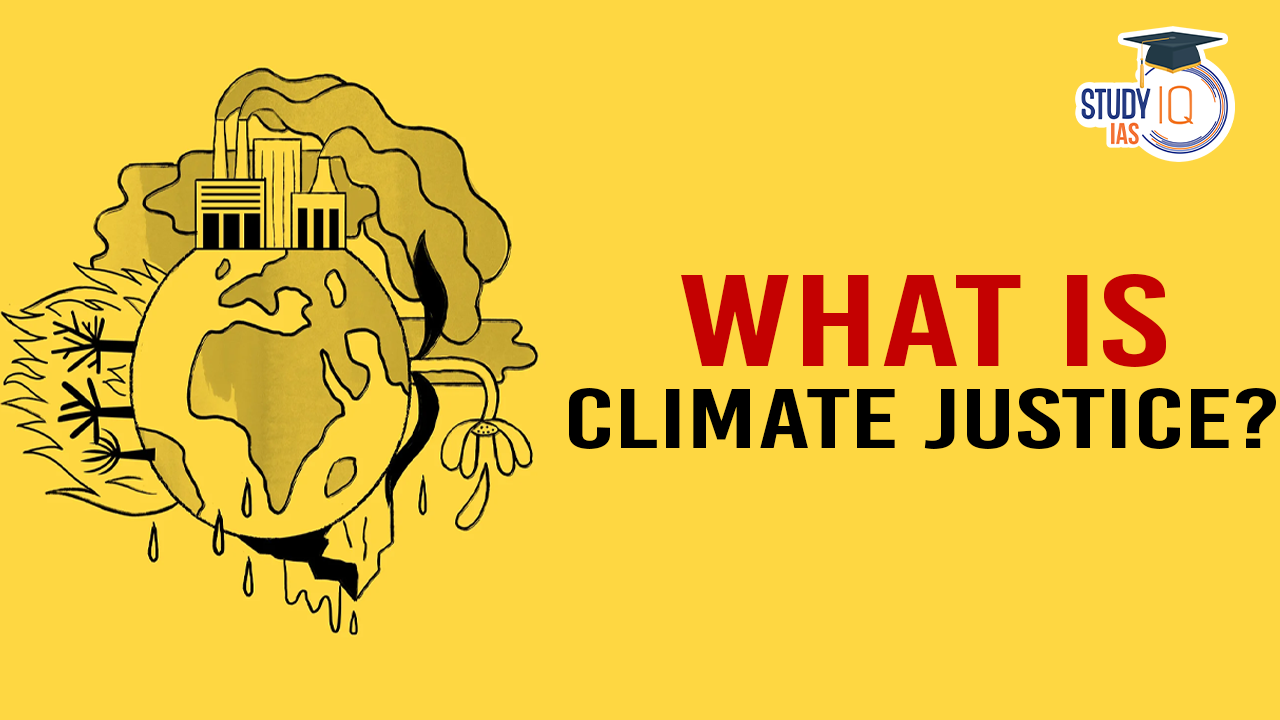Table of Contents
Context: President Droupadi Murmu during her address to the Fijian parliament said that India will push the developed countries for climate justice for Fiji and other ocean states.
About Climate Justice
- Climate justice frames global warming as an ethical and political issue rather than purely environmental or physical.
- It recognizes that climate change affects underprivileged populations differently in terms of social, economic, public health, and other adverse impacts.
- The effects of climate change, such as extreme weather and rising sea levels, are not borne equally or fairly across different socioeconomic groups, genders, and generations.
- Historically marginalised or underserved communities often experience disproportionate effects of climate change.
- Pursuing climate justice involves addressing interconnected social, gender, economic, intergenerational, and environmental injustices.
- Some climate projects can unintentionally create injustices, such as displacing local communities for conservation or renewable energy initiatives.
- Advocates for climate justice seek to address these inequities through long-term mitigation and adaptation strategies.
Types of Justice under Climate Justice
- Procedural Climate Justice: Ensures fair, accountable, and transparent decision-making about climate change effects and solutions. It involves public participation, access to information, and unbiased decision-makers, promoting transparency, fair representation, impartiality, and objectivity.
- Distributive Climate Justice: Focuses on how the costs and benefits of climate change are shared. It involves:
- Identifying what goods are being distributed (e.g., food, water, power).
- Determining who will receive these goods (e.g., certain communities, generations).
- Choosing the fairest method of distribution (e.g., based on need, merit, rights).
- Recognition Climate Justice: Emphasises recognizing and addressing the differences and vulnerabilities of people, particularly those who may be more affected by low-carbon transitions. It focuses on protecting equal rights and understanding diverse needs and capacities.
- Intergenerational Climate Justice: Highlights the importance of meeting current needs without compromising future generations’ ability to meet theirs. This concept was first recognized in the Brundtland Report ‘Our Common Future’ (1987).
| Intergenerational and Intragenerational Equity |
|
Importance of Climate Justice
- Human Rights Issue: Climate change affects human rights, threatening the ability of all people to live with dignity.
- The climate crisis results in loss of lives, livelihoods, language, and culture, risking food and water shortages, and triggering displacement and conflict.
- Health Impacts: The climate crisis impedes the right to good health.
- Rising temperatures, extreme weather events, and pollution cause health issues such as heat stress, disease outbreaks, malnutrition, and trauma from disasters.
- Vulnerable Populations: Vulnerable populations, with limited means to adapt, face more severe impacts.
- Between 2010 and 2020, mortality from floods, droughts, and storms was 15 times higher in highly vulnerable regions compared to regions with low vulnerability.
- Education System Impacts: High temperatures and extreme weather can damage educational infrastructure.
- Disruptions threaten parents’ ability to send children to school, impacting future generations’ education and opportunities.
- Just Transition: Climate justice is crucial for a just transition to a sustainable future.
- Protecting and consulting local communities, especially informal workers and marginalised populations, is necessary to avoid harm during this transition.
- Concerns include human rights violations related to mining for minerals needed for electric vehicle batteries.
- Disproportionate Impact: Those who have least contributed to the climate crisis are disproportionately affected.
- Responsibilities for addressing climate change should be aligned with the level of contribution to the problem.
- Addressing systemic, socioeconomic, and intergenerational inequalities is essential.
Challenges in Ensuring Climate Justice
- Gradual Dilution of Common but Differentiated Responsibilities (CBDR): Article 3 of the UNFCCC acknowledges CBDR based on differences between developed and developing countries’ circumstances and historical contributions.
- Developed countries push for higher commitments from developing countries, e.g., advocating for a coal “phase-out” at Glasgow 2021 (later agreed to “phase-down”).
- Phasing out coal imposes significant costs on developing countries due to its status as a cheap energy source.
- Avoidance of Binding Targets: Nationally Determined Contributions (NDCs) under the Paris Agreement are voluntary and not legally binding.
- The Kyoto Protocol had binding targets for developed countries, but it has become non-functional.
- Developed countries avoid binding targets, reneging on their historical responsibilities.
- Shortfall in Climate Finance: Developed countries have not met the pledge of providing US$ 100 billion per year for Climate Finance.
- Experts argue that US$ 100 billion per year is insufficient to address climate change.
- IPCC estimates that US$ 1.6–3.8 trillion annually is needed to prevent warming exceeding 1.5°C.
Suggestions for Ensuring Climate Justice
- Predictable and Assured Climate Finance: Address intragenerational equity through predictable and assured climate finance.
- Establish binding targets for developed countries to fund vulnerable countries, proportionate to their historical contributions.
- Augmenting Climate Finance with Technology Transfer: Increase climate finance by transferring technology to developing nations.
- Accelerate the transition to low-carbon economies in developing countries.
- Mainstreaming Climate Justice into Disaster Relief: Recognize that climate-induced disasters may become the norm.
- Integrate climate justice concerns into disaster relief efforts.
- Ensure the Loss and Damage Fund provides unconditional relief based on climate justice principles.
- Binding Emission Reduction Targets for Developed Countries: Developed countries should acknowledge their historical responsibility and commit to binding emission reduction targets.
- Intragenerational Equity within Developing Countries: Developing countries should focus on ensuring intragenerational equity within their societies.
- Promote climate education and engagement initiatives.


 UNESCO Global Network of Learning Cities...
UNESCO Global Network of Learning Cities...
 National Livestock Mission (NLM): Object...
National Livestock Mission (NLM): Object...

























